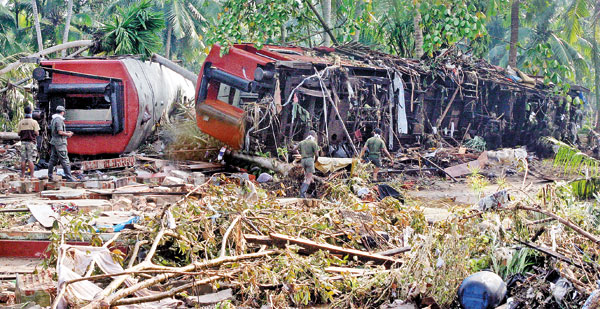Sunday Times 2
Taking care of the visitors amidst the chaos
View(s):By Feizal Samath
When the tsunami on December 26, 2004 devastated a large portion of Sri Lanka’s eastern, southern and south-western beaches and hotels that stood in the way and stranded many tourists, the country’s tourism industry had to rally together to miminise inconvenience to travellers.
“We brought the industry under one unit and worked hard to ease the pain and suffering of many of the affected,” recalled Udaya Nanayakkara, then Chairman of the Sri Lanka Tourist Board.
Nearly 30,000 people including tourists died in the worst-ever natural disaster in this country which also displaced over 1.5 million. At least 50,000 tourists were affected and around 2,000 were dead or missing. The worst affected were the southern and west coasts along with the east coast. Sri Lanka’s efforts to care for stranded tourists and the handling of the crisis were complimented by the World Tourism Organisation (WTO). There were lots of letters of appreciation from embassies and other quarters.
Recalling the events of that fatal day, Abbas Esufally, Director at Hemas Group, said he received a call from his General Manager at Serendib Hotel on the south coast saying they had to evacuate all their guests as the entire ground floor was flooded. “I told him that they faced a major logistics problem as roads were flooded, damaged and trees had fallen preventing buses from going to the scene to bring the tourists to Colombo.”
The roads had to be cleared first.
Giving his experience of the events, Mr. Nanayakkara said: “Once the tsunami happened, my immediate response was to summon all the Destination Management Companies (DMCs) as this was peak winter season.
“We collected all the tourists’ numbers from DMCs, where they were and their fixed itineraries. We opened an emergency office at the BMICH – which became the nerve centre of operations. Tourist Board directors in London, Frankfurt and Paris were requested to fly down to Colombo immediately. Since we had a public emergency and since Tourist Board staff had their own work to do and also had to care for their own families who were affected, I contacted the international schools and brought in senior students as volunteers to man the desk 24/7.
“ We used radio and TV announcements to track tourists with a central call-in number. Halls in Buddhist temples were used to ask tourists to congregate. They had lost passports/money and everything they owned.
“Since the railway was affected, we sent buses, sometimes accompanied by students, to bring the tourists to Colombo. A large number was accommodated at the BMICH. We also asked hotels to help in turning their ballrooms into dormitories.
“We asked Arpico and other stores to provide us with beds, mattresses, bed linen and towels – all three meals were provided to stranded tourists.

“We gave cash vouchers to tourists to buy clothing and other needs from supermarkets. We were in contact with counsellors of key embassies here and others based in Delhi who came down to Sri Lanka where there was a desk at the BMICH to issue temporary passports. Airlines set up computer terminals at the BMICH and through this we were able to track flights and passport details of those who lost passports. All this activity was funded by the Tourist Board. Doctors were at the BMICH attending to minor injuries and offering trauma counselling.
“We reached out to the world giving contact numbers for relatives of tourists to get in touch with us. We had a play area in the BMICH gardens to keep children occupied.”
He said within eight months hotels were renovated in time for the 2005 winter season. Hotels were provided with concessions to import equipment and raw material.
Mr. Esufally, meanwhile, said they were responsible for 1,976 stranded travellers.“We found everyone except for two who were missing,” he added.

